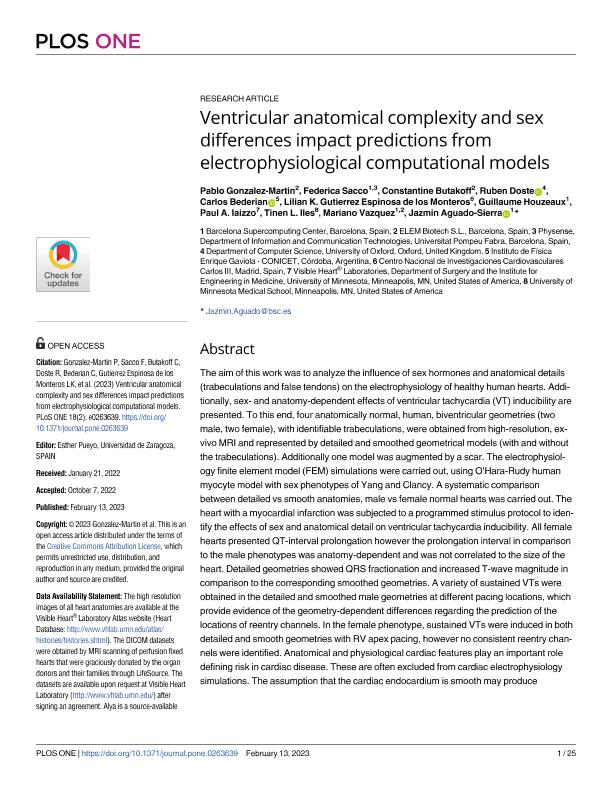Mostrar el registro sencillo del ítem
dc.contributor.author
Gonzalez Martin, Pablo
dc.contributor.author
Sacco, Federica
dc.contributor.author
Butakoff, Constantine
dc.contributor.author
Doste, Ruben
dc.contributor.author
Bederian, Carlos Sergio

dc.contributor.author
Gutierrez Espinosa de los Monteros, Lilian K.
dc.contributor.author
Houzeaux, Guillaume
dc.contributor.author
Iaizzo, Paul A.
dc.contributor.author
Iles, Tinen L.
dc.contributor.author
Vazquez, Mariano
dc.contributor.author
Aguado Sierra, Jazmin
dc.date.available
2024-02-09T13:51:12Z
dc.date.issued
2023-02
dc.identifier.citation
Gonzalez Martin, Pablo; Sacco, Federica; Butakoff, Constantine; Doste, Ruben; Bederian, Carlos Sergio; et al.; Ventricular anatomical complexity and sex differences impact predictions from electrophysiological computational models; Public Library of Science; Plos One; 18; 2-2023; 1-25
dc.identifier.issn
1932-6203
dc.identifier.uri
http://hdl.handle.net/11336/226590
dc.description.abstract
The aim of this work was to analyze the influence of sex hormones and anatomical details (trabeculations and false tendons) on the electrophysiology of healthy human hearts. Additionally, sex- and anatomy-dependent effects of ventricular tachycardia (VT) inducibility are presented. To this end, four anatomically normal, human, biventricular geometries (two male, two female), with identifiable trabeculations, were obtained from high-resolution, ex-vivo MRI and represented by detailed and smoothed geometrical models (with and without the trabeculations). Additionally one model was augmented by a scar. The electrophysiology finite element model (FEM) simulations were carried out, using O’Hara-Rudy human myocyte model with sex phenotypes of Yang and Clancy. A systematic comparison between detailed vs smooth anatomies, male vs female normal hearts was carried out. The heart with a myocardial infarction was subjected to a programmed stimulus protocol to identify the effects of sex and anatomical detail on ventricular tachycardia inducibility. All female hearts presented QT-interval prolongation however the prolongation interval in comparison to the male phenotypes was anatomy-dependent and was not correlated to the size of the heart. Detailed geometries showed QRS fractionation and increased T-wave magnitude in comparison to the corresponding smoothed geometries. A variety of sustained VTs were obtained in the detailed and smoothed male geometries at different pacing locations, which provide evidence of the geometry-dependent differences regarding the prediction of the locations of reentry channels. In the female phenotype, sustained VTs were induced in both detailed and smooth geometries with RV apex pacing, however no consistent reentry channels were identified. Anatomical and physiological cardiac features play an important role defining risk in cardiac disease. These are often excluded from cardiac electrophysiology simulations. The assumption that the cardiac endocardium is smooth may produce inaccurate predictions towards the location of reentry channels in in-silico tachycardia inducibility studies.
dc.format
application/pdf
dc.language.iso
eng
dc.publisher
Public Library of Science

dc.rights
info:eu-repo/semantics/openAccess
dc.rights.uri
https://creativecommons.org/licenses/by-nc-sa/2.5/ar/
dc.subject
Heart
dc.subject
Tachycardia
dc.subject.classification
Biofísica

dc.subject.classification
Ciencias Biológicas

dc.subject.classification
CIENCIAS NATURALES Y EXACTAS

dc.title
Ventricular anatomical complexity and sex differences impact predictions from electrophysiological computational models
dc.type
info:eu-repo/semantics/article
dc.type
info:ar-repo/semantics/artículo
dc.type
info:eu-repo/semantics/publishedVersion
dc.date.updated
2024-02-08T10:56:53Z
dc.journal.volume
18
dc.journal.pagination
1-25
dc.journal.pais
Estados Unidos

dc.description.fil
Fil: Gonzalez Martin, Pablo. Barcelona Supercomputing Center - Centro Nacional de Supercomputacion; España
dc.description.fil
Fil: Sacco, Federica. Universitat Pompeu Fabra; España. Barcelona Supercomputing Center - Centro Nacional de Supercomputacion; España
dc.description.fil
Fil: Butakoff, Constantine. Barcelona Supercomputing Center - Centro Nacional de Supercomputacion; España
dc.description.fil
Fil: Doste, Ruben. University of Oxford; Reino Unido
dc.description.fil
Fil: Bederian, Carlos Sergio. Consejo Nacional de Investigaciones Científicas y Técnicas. Centro Científico Tecnológico Conicet - Córdoba. Instituto de Física Enrique Gaviola. Universidad Nacional de Córdoba. Instituto de Física Enrique Gaviola; Argentina
dc.description.fil
Fil: Gutierrez Espinosa de los Monteros, Lilian K.. Instituto de Salud Carlos III; España
dc.description.fil
Fil: Houzeaux, Guillaume. Barcelona Supercomputing Center - Centro Nacional de Supercomputacion; España
dc.description.fil
Fil: Iaizzo, Paul A.. University of Minnesota; Estados Unidos
dc.description.fil
Fil: Iles, Tinen L.. University of Minnesota; Estados Unidos
dc.description.fil
Fil: Vazquez, Mariano. Barcelona Supercomputing Center - Centro Nacional de Supercomputacion; España
dc.description.fil
Fil: Aguado Sierra, Jazmin. Barcelona Supercomputing Center - Centro Nacional de Supercomputacion; España
dc.journal.title
Plos One

dc.relation.alternativeid
info:eu-repo/semantics/altIdentifier/url/https://journals.plos.org/plosone/article?id=10.1371/journal.pone.0263639
dc.relation.alternativeid
info:eu-repo/semantics/altIdentifier/doi/http://dx.doi.org/10.1371/journal.pone.0263639
Archivos asociados
